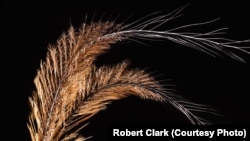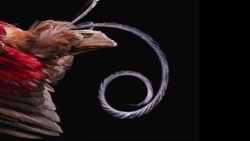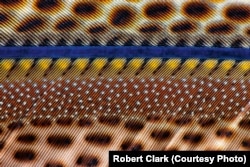Taking pictures of feathers was a dream assignment for photographer Robert Clark, who loves nature and finds beauty in birds.
“It started as a magazine article,” he recalls. “We were lucky. We were working with some scientists. And we went to China, shot a lot of the fossil evidence of feathers, which takes us to the origin of feathers way back in time, to 160 million years old or so. We went to feather collections around the world.
"I also made some visits to different zoos around the United States. And we spent a lot of time in taxidermy shops. So I was able to shoot some of the things that were extinct, like passenger pigeons and Carolina parakeets.”
Focus on feathers
These photographic journeys took about a year and resulted in a new book, Feathers: Displays of Brilliant Plumage. Along with dozens of bold, eye-popping images, Clark includes information that many people may not know about feathers, such as structural color.
“When you look at a feather from different angles, it has an iridescence to it. A peacock feather is a great example, where it goes from blue to green to a kind of a purple color. The color is built to the design, and to the shape of the feather," he said. "The reason it looks different is that the light goes through it and then the light is bent, not just reflected, and comes out in a little bit different direction. So it creates this iridescence. There is a lot of reason for it — sexual attraction, camouflage and different things like that.”
Portraits in the book — and they are portraits — illustrate the diversity in feathers’ shape and function. The southern cassowary, for example, can't fly, so its coarse, hairlike feathers serve mostly as insulation and protection.
That’s not the case for the lesser snow goose.
“It’s a migratory bird and it’s a high flier. So it has these very aerodynamic wings," Clark said. "It has a uvula coming off of it. It’s like a thumb on the top part of it. I think it’s a beautiful, beautiful wing. It’s not very colorful, but certainly a very well composed wing.”
Other birds’ feathers are designed to attract mates.
“The great argus is a bird that is kind of drab in color, but then it lifts its wing up and there comes this multicolor pattern: blue, yellow and little speckles all over it,” he explains.
“Some of the biologists I’ve spoken with believe that the pattern replicates some of the seeds that the birds eat. So when you show a female, 'Hey, I have all these seeds,' they're attracted to a bird that has more food. So there are little things like this that you learn that makes feathers even more interesting,” Clark added.
Same approach to highlight differences
As a photographer, Clark says he followed a very direct approach in aiming his lens at the feathers.
“I photographed them in a very similar fashion because I wanted the difference to be the feather, not the lighting or the composition or the background," he said. "I wanted it to be a comparison from feather to feather. So I wanted it to be a photographic study where everything is the same. So when you look at them what you see is the difference.”
Clark hopes people will look at his photographs and discover what he realized while working on this project. “I found something that you see all the time in nature," he marvels, but “it wasn’t until I really stopped and looked at that I totally appreciated it. I think people need to slow down and look at things.“











